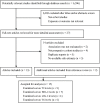Serum Lipids and Breast Cancer Risk: A Meta-Analysis of Prospective Cohort Studies
- PMID: 26554382
- PMCID: PMC4640529
- DOI: 10.1371/journal.pone.0142669
Serum Lipids and Breast Cancer Risk: A Meta-Analysis of Prospective Cohort Studies
Abstract
Purpose: Epidemiologic studies exploring causal associations between serum lipids and breast cancer risk have reported contradictory results. We conducted a meta-analysis of prospective cohort studies to evaluate these associations.
Methods: Relevant studies were identified by searching PubMed and EMBASE through April 2015. We included prospective cohort studies that reported relative risk (RR) estimates with 95% confidence intervals (CIs) for the associations of specific lipid components (i.e., total cholesterol [TC], high-density lipoprotein cholesterol [HDL-C], low-density lipoprotein cholesterol [LDL-C], and triglycerides [TG]) with breast cancer risk. Either a fixed- or a random-effects model was used to calculate pooled RRs.
Results: Fifteen prospective cohort studies involving 1,189,635 participants and 23,369 breast cancer cases were included in the meta-analysis. The pooled RRs of breast cancer for the highest versus lowest categories were 0.96 (95% CI: 0.86-1.07) for TC, 0.92 (95% CI: 0.73-1.16) for HDL-C, 0.90 (95% CI: 0.77-1.06) for LDL-C, and 0.93 (95% CI: 0.86-1.00) for TG. Notably, for HDL-C, a significant reduction of breast cancer risk was observed among postmenopausal women (RR = 0.77, 95% CI: 0.64-0.93) but not among premenopausal women. Similar trends of the associations were observed in the dose-response analysis.
Conclusions: Our findings suggest that serum levels of TG but not TC and LDL-C may be inversely associated with breast cancer risk. Serum HDL-C may also protect against breast carcinogenesis among postmenopausal women.
Conflict of interest statement
Figures





Similar articles
-
Association between serum lipids and breast cancer risk in premenopausal women: systematic review and meta-analysis.J Int Med Res. 2021 Nov;49(11):3000605211061033. doi: 10.1177/03000605211061033. J Int Med Res. 2021. PMID: 34851759 Free PMC article.
-
Blood lipids profile and lung cancer risk in a meta-analysis of prospective cohort studies.J Clin Lipidol. 2017 Jul-Aug;11(4):1073-1081. doi: 10.1016/j.jacl.2017.05.004. Epub 2017 May 31. J Clin Lipidol. 2017. PMID: 28669687
-
Serum high-density lipoprotein cholesterol, metabolic profile, and breast cancer risk.J Natl Cancer Inst. 2004 Aug 4;96(15):1152-60. doi: 10.1093/jnci/djh216. J Natl Cancer Inst. 2004. PMID: 15292387
-
An Updated Systematic Review and Meta-Analysis on Association of Serum Lipid Profile With Risk of Breast Cancer Incidence.Int J Prev Med. 2022 Nov 23;13:142. doi: 10.4103/ijpvm.IJPVM_285_20. eCollection 2022. Int J Prev Med. 2022. PMID: 36618541 Free PMC article. Review.
-
Risk of breast cancer in relation to blood lipids: a prospective study of 31,209 Norwegian women.Cancer Causes Control. 1994 Nov;5(6):501-9. doi: 10.1007/BF01831377. Cancer Causes Control. 1994. PMID: 7827236
Cited by
-
Role of Serum Lipids, Blood Glucose and Blood Pressure in Breast Cancer Risk for Women with Type 2 Diabetes Mellitus.Clin Epidemiol. 2023 Jan 24;15:109-121. doi: 10.2147/CLEP.S386471. eCollection 2023. Clin Epidemiol. 2023. PMID: 36718225 Free PMC article.
-
Circulating 27-hydroxycholesterol, lipids, and steroid hormones in breast cancer risk: a nested case-control study of the Multiethnic Cohort Study.Breast Cancer Res. 2023 Aug 14;25(1):95. doi: 10.1186/s13058-023-01693-6. Breast Cancer Res. 2023. PMID: 37580793 Free PMC article.
-
Association between serum lipids and breast cancer risk in premenopausal women: systematic review and meta-analysis.J Int Med Res. 2021 Nov;49(11):3000605211061033. doi: 10.1177/03000605211061033. J Int Med Res. 2021. PMID: 34851759 Free PMC article.
-
Circulating lipids, lipid-lowering drug targets, and breast cancer risk: Comprehensive evidence from Mendelian randomization and summary data-based Mendelian randomization.Cancer Causes Control. 2024 Jun;35(6):983-994. doi: 10.1007/s10552-024-01857-5. Epub 2024 Mar 2. Cancer Causes Control. 2024. PMID: 38430374
-
Metabolic profiling of adherence to diet, physical activity and body size recommendations for cancer prevention.Sci Rep. 2018 Nov 2;8(1):16293. doi: 10.1038/s41598-018-34662-7. Sci Rep. 2018. PMID: 30390014 Free PMC article.
References
-
- Smith DG. Epidemiology of dyslipidemia and economic burden on the healthcare system. The Am J Manag Care. 2007; 13 Suppl 3: S68–71. - PubMed
-
- Eliassen AH, Hankinson SE. Endogenous hormone levels and risk of breast, endometrial and ovarian cancers: prospective studies. Adv Exp Med Biol. 2007; 630: 148–165. - PubMed
-
- Hoyer AP, Engholm G. Serum lipids and breast cancer risk: a cohort study of 5,207 Danish women. Cancer Causes Control. 1992; 3: 403–408. - PubMed
Publication types
MeSH terms
Substances
LinkOut - more resources
Full Text Sources
Other Literature Sources
Medical
Miscellaneous

